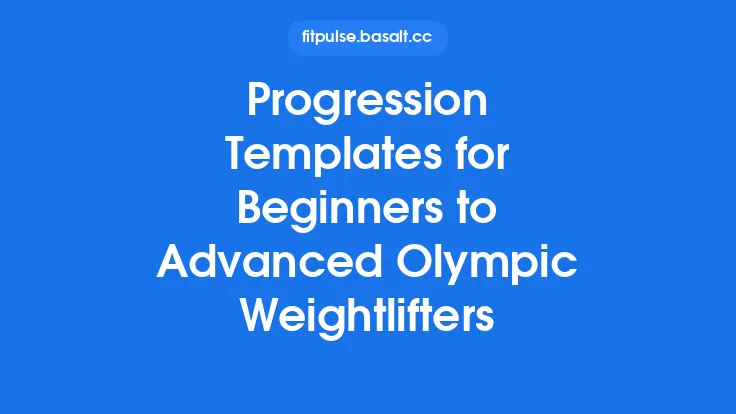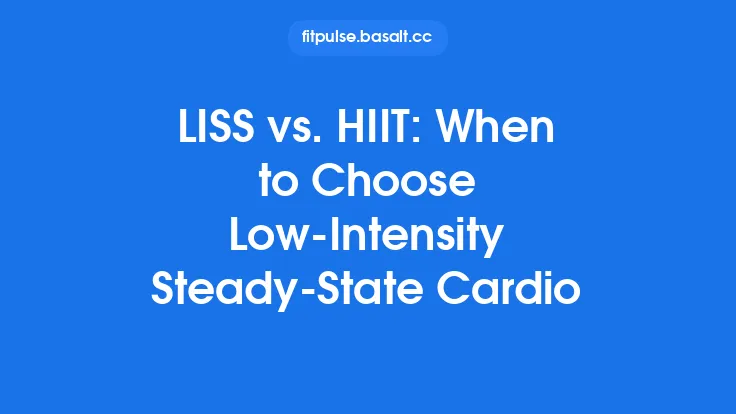When it comes to designing an effective training program, the line between forward momentum and stagnation can be surprisingly thin. Athletes and recreational lifters alike often find themselves asking: “Am I ready to push the load higher, or should I pull back and let my body catch up?” The answer lies in a systematic, data‑driven approach that balances the physiological demands of progressive overload with the body’s need for recovery and adaptation. Below is a comprehensive guide to recognizing the tell‑tale signs of genuine progression, identifying when a plateau has set in, and deciding whether to advance the stimulus or scale back for optimal long‑term development.
Understanding the Underlying Physiology
1. The Adaptation Cycle
Every training stimulus initiates a three‑phase cycle:
- Stress – Mechanical tension, metabolic fatigue, and neural demand placed on the tissues.
- Recovery – Cellular repair, protein synthesis, hormonal rebalancing, and neural recalibration.
- Supercompensation – The point at which the body adapts beyond its original baseline, resulting in measurable performance gains.
If the cycle is completed efficiently, the next training session can be built upon a higher baseline. Conversely, if recovery is insufficient, the system regresses, leading to performance decrements or a plateau.
2. Central vs. Peripheral Fatigue
- Central fatigue originates in the nervous system, manifesting as reduced motor unit recruitment, slower reaction times, and diminished motivation.
- Peripheral fatigue is localized to the muscle fibers, evident through decreased force production, altered muscle contractility, and increased perceived exertion.
Distinguishing between these two forms of fatigue helps determine whether the bottleneck is neural (often a cue to reduce intensity or volume) or muscular (suggesting a need for more recovery or a shift in stimulus).
3. Hormonal and Immune Markers
While not always practical for the everyday lifter, tracking cortisol, testosterone, and inflammatory cytokines can provide objective insight into systemic stress. Elevated cortisol paired with suppressed testosterone over several weeks is a red flag that the body is operating in a catabolic state, signaling the need to scale back.
Objective Metrics: When Numbers Speak
Performance Benchmarks
- One‑Rep Max (1RM) Trends – A consistent upward trajectory over 3–4 testing points (spaced 4–6 weeks apart) is a strong indicator that progression is sustainable.
- Velocity-Based Training (VBT) – Mean propulsive velocity (MPV) for a given load should remain stable or improve; a sudden drop of >5% often precedes a plateau.
- Repetition Velocity Loss (RVL) – Excessive velocity loss within a set (>20% for strength work) suggests accumulating fatigue.
Load‑Volume Relationships
- Total Work (Load × Reps × Sets) – Plotting total work over time can reveal a “flattening” curve, where increases in load are offset by reductions in volume, indicating a plateau.
- Training Impulse (TRIMP) – Combining intensity and duration into a single score helps compare sessions; a plateau in TRIMP despite varied programming may signal adaptation saturation.
Physiological Monitoring
- Heart Rate Variability (HRV) – A sustained drop in HRV (especially the RMSSD metric) over several days suggests insufficient recovery.
- Resting Heart Rate (RHR) – An upward drift of 3–5 bpm from baseline can be an early warning of systemic stress.
Subjective Indicators: Listening to the Body
Perceived Exertion (RPE) Trends
If a workout that previously felt like a 6/10 now registers as an 8/10 despite identical programming, the athlete is likely operating under accumulated fatigue.
Motivation and Mood
A noticeable decline in enthusiasm, increased irritability, or a sense of dread before training sessions often correlates with overreaching.
Sleep Quality
Reduced sleep efficiency (<85%) or fragmented sleep patterns for more than a week can impair recovery pathways, nudging the athlete toward a plateau.
Joint and Tissue Feedback
Persistent joint soreness, lingering muscle stiffness, or a sense of “tightness” that does not resolve with standard mobility work may indicate that the musculoskeletal system is not fully recuperating.
Decision Framework: Advance or Scale Back?
Below is a practical decision tree that integrates the objective and subjective data points discussed above.
| Situation | Objective Cue | Subjective Cue | Recommended Action |
|---|---|---|---|
| Consistent performance gains (↑1RM, stable/increasing VBT) | Positive trend over 3–4 testing points | High motivation, good sleep, low RPE | Advance – increase load (2‑5%) or add a set |
| Minor performance dip (≤2% drop) but stable HRV and mood | Small regression in metrics | No major fatigue, normal sleep | Fine‑tune – adjust rest intervals or tempo |
| Stagnant performance for >2 weeks | Flat work‑volume curve, velocity loss >15% | Elevated RPE, slight mood dip | Scale Back – deload 10‑20% volume or intensity |
| Clear performance decline (≥5% drop) + elevated cortisol or HRV drop | Negative trend in multiple metrics | High fatigue, poor sleep, low motivation | Regress – reduce load 20‑30%, increase recovery modalities |
| Central fatigue signs (slow reaction, mental fog) | No change in peripheral metrics | Low motivation, high RPE | Neural Reset – reduce intensity, incorporate active recovery |
| Peripheral fatigue signs (muscle soreness, reduced force) | Decreased velocity, increased RVL | Normal mood, adequate sleep | Recovery Focus – add extra rest days, consider light technique work |
Practical Strategies for Advancement
- Incremental Load Increases – Add 2–5% to the working weight once the athlete can complete the prescribed reps with an RPE ≤6 for two consecutive sessions.
- Set and Rep Manipulation – If load progression stalls, increase the number of sets (e.g., from 3 to 4) while keeping the load constant, then revisit load increments after a week.
- Tempo Adjustments – Slowing the eccentric phase (e.g., 3‑second lowering) can increase time under tension without changing load, providing a novel stimulus.
- Rest Interval Tweaks – Shortening rest by 15–30 seconds can raise metabolic stress, while lengthening rest can improve maximal strength output. Choose based on the specific adaptation goal.
- Exercise Variation – Swap a primary lift for a biomechanically similar alternative (e.g., barbell bench press → dumbbell press) to stimulate slightly different motor patterns while maintaining overall load.
Effective Methods for Scaling Back
- Deload Weeks – Reduce total volume by 40‑60% while maintaining relative intensity (e.g., 80% of 1RM) for 1–2 sessions, then return to normal load.
- Active Recovery Sessions – Replace a heavy day with low‑intensity, high‑repetition work (e.g., bodyweight circuits) to promote blood flow without adding stress.
- Frequency Reduction – Drop training frequency for the affected muscle group from 3×/week to 2×/week for a short period.
- Load Reduction – Decrease the working weight by 10‑20% for a set of sessions, allowing the nervous system to reset.
- Technique Emphasis – Use the regression period to focus on perfecting form, which can improve long‑term efficiency and reduce injury risk.
Integrating Recovery Science
Even the most sophisticated progression plan will falter without a solid recovery foundation. Consider the following evergreen pillars:
- Nutrition – Ensure protein intake of 1.6–2.2 g/kg body weight daily, and align carbohydrate timing with training windows to replenish glycogen.
- Sleep Hygiene – Aim for 7–9 hours of uninterrupted sleep; incorporate a wind‑down routine to stabilize circadian rhythms.
- Hydration – Even mild dehydration (≥2% body mass loss) can impair strength and power output.
- Stress Management – Incorporate mindfulness, breathing exercises, or low‑intensity cardio to modulate cortisol levels.
- Mobility Maintenance – While not the focus of this article, regular dynamic warm‑ups and post‑workout stretching support joint health and can accelerate recovery.
A Sample Weekly Monitoring Routine
| Day | Metric | Target | Action Threshold |
|---|---|---|---|
| Mon | 1RM test (or submax estimate) | ↑ or stable | If ↓ >2% → consider regression |
| Tue | HRV (morning) | Within 5% of baseline | ↓ >10% → schedule deload |
| Wed | RPE for main lift | ≤6 | >7 for two sessions → reduce load |
| Thu | Sleep efficiency | ≥85% | <80% for >3 nights → add recovery day |
| Fri | Velocity (VBT) | No >5% drop | Drop → adjust volume |
| Sat | Mood questionnaire | Positive | Negative trend → consider scaling back |
| Sun | Rest | Full recovery | N/A |
By consistently logging these data points, the athlete creates a feedback loop that informs whether to push forward or pull back, turning the often‑intuitive “feel‑good” approach into a measurable, evidence‑based process.
Bottom Line
Progression and plateaus are two sides of the same coin—both are natural outcomes of the body’s adaptation cycle. The key to sustainable development lies in:
- Objective tracking of performance, physiological, and recovery metrics.
- Subjective awareness of fatigue, motivation, and overall well‑being.
- A clear decision framework that tells you when to add load, volume, or complexity, and when to deliberately step back.
By treating each training block as a data set rather than a guess, coaches and athletes can make informed adjustments that keep the progression curve moving upward while minimizing the risk of chronic fatigue or injury. The result is a resilient, adaptable training program that continues to deliver gains long after the initial enthusiasm fades.





